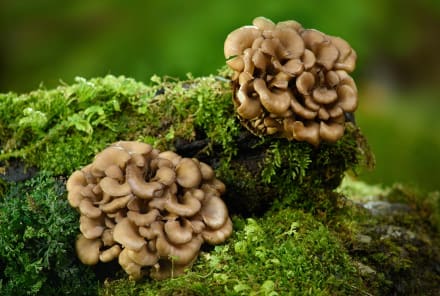Advertisement
7 Signs You Might Have Candida Overgrowth


Candida albicans is a type of fungus that grows on pretty much everyone—and mostly doesn't cause a problem. But sometimes it can get out of control and morph into candidiasis, or candida overgrowth. And that can trigger a host of seemingly unrelated health issues, from skin rashes to yeast infections.
So how can you tell if you have it? Many of the symptoms of candida overgrowth are vague, so the first step is often paying close attention to some of the subtle (or not so subtle) signals your body might be sending out. Here are seven biggies worth paying attention to, plus what to do about them.
What causes candida overgrowth?
Small amounts of candida normally live on and in the body, in places like the skin, the mouth, the throat, the gut, and the vagina. It's usually kept in check by the body's good bacteria and doesn't cause a problem.
But certain factors can disrupt the normal balance of good bacteria and fungi. "That can lead to an increase in candida," explains functional medicine doctor Wendie Trubow, M.D. These can include:
- Taking antibiotics.
- Having a weakened immune system, either from a health condition (like diabetes1 or HIV), or from taking immunosuppressive medications like steroids or chemotherapy.
- Taking birth control2, especially high-dose estrogen birth control pills.
- Eating a diet high in refined carbs or sugar3.
- Excessive alcohol consumption4.
- High levels of stress5.
Any one of these factors might not necessarily be enough to cause candida overgrowth on its own, but if you're dealing with more than one, the combination could add up to a perfect storm for candida. "For instance, when your defenses are down from a weakened immune system and reduced bacterial diversity, eating sugar can become a problem," explains Nour Zibdeh, M.S., RDN.
7 signs of candida overgrowth
An overgrowth of candida can manifest in a number of symptoms. A few of them are fairly distinct, while others tend to be vague. That can make diagnosing candida overgrowth challenging. "There are a number of symptoms, although someone might not put the puzzle together on their own," says Trubow.
Looking at multiple symptoms as a whole can help you and your health care provider figure out whether you're dealing with candida. Here are some of the most common ones to watch for:
White patches in your mouth
A white, cheese-like coating on your tongue, inner cheeks, throat, or the roof of your mouth can all be a sign of candida overgrowth in the mouth—usually called oral thrush6. Often, it's triggered by a weakened immune system7 or antibiotic use, but it can also stem from dry mouth or hormonal changes (like those that occur during pregnancy).
Thrush can come on suddenly, and you’ll know it when you see it. In addition to that white coating in your mouth, you might have trouble tasting or swallowing, or feel like your mouth is full of cotton. You might notice redness or soreness around the edges of your mouth too.
Frequent yeast infections
Yeast infections8 are caused by an overgrowth of candida. They sometimes develop after taking antibiotics but can also come on with hormonal changes from pregnancy or taking high-estrogen birth control. Most women will get a yeast infection at some point—but if it seems like you get them over and over, you might have a problem with candida overgrowth. Yeast infections are usually marked by vaginal soreness or swelling, intense itching, pain when you pee or have sex, and discharge that's thick and white.
Frequent urinary tract infections
Similar to yeast infections, most people will deal with a urinary tract infection at some point. Usually, they're marked by feeling like you constantly have to pee, even if not much actually comes out. You might also feel a burning sensation while peeing or notice that your urine is cloudy, red, or smells extra strong.
The candida fungus is one of the most common causes9 of urinary tract infections—so if UTIs feel like a regular thing for you, they could be a sign of candida overgrowth.
GI problems
Having any health condition that suppresses the immune system can raise the risk for candida overgrowth. But it might be especially true for inflammatory bowel diseases like Crohn's disease or ulcerative colitis.
Candida is the culprit10 behind most fungal infections in people with IBD, likely because an imbalance of good bacteria in the gut makes it easier for fungi like candida to flourish. While IBD symptoms can be individualized, they're typically marked by belly pain and cramping, diarrhea or bloody stool, diminished appetite, and weight loss.
Frequent skin infections
Candida normally lives on the surface of the skin. But sometimes the fungi can make their way beneath the skin's surface and cause a nasty infection. This might look like scaly dry skin, toenail fungus, or dandruff.
Since candida loves warm, moist environments, the infections often end up forming between skin creases or folds—like the armpit, groin, torso, or under the breasts. They're typically marked by an itchy rash that looks like a cluster of tiny red pimples.
Joint pain
Candida often flares up in the mouth, gut, or vagina, but it can also travel through the bloodstream and spread to other parts of the body. And this type of overgrowth, called invasive candida11, can sometimes settle in the joints and cause arthritis-like pain in the hips or knees12.
However, sore or achy joints alone might not tip you off to a candida problem. So it's even more important to pay attention to any other issues that could clue you in to what's going on. "Additional symptoms might be fatigue, brain fog, skin rashes, abdominal bloating, diarrhea, constipation, or thinning hair," Trubow says.
Fever and chills
That flu-like feeling is a telltale sign that the body is trying to fight an infection—including invasive candida overgrowth. Still, how can you know that your fever and chills are actually caused by candida instead of something else? One clue might be if your doctor prescribes antibiotics for your symptoms and they don't get better. That could be a sign that you're dealing with a fungal infection13 rather than a bacterial one.
How to test for candida overgrowth
Symptoms can tip you off to a possible candida problem. But the only way to tell whether you have too much of the fungi is to get tested by a health care provider.
The test itself is simple and straightforward: Your provider will check for candida overgrowth by drawing your blood or taking a sample of your urine or stool. The sample is sent to a lab and cultured to test for the candida fungus14.
Is one type of test better than the others? Not necessarily, says Trubow. The test your provider picks will likely depend on your specific symptoms. (Frequent yeast infections or UTIs9 might warrant a urine test, for instance.) Sometimes she might opt to confirm the diagnosis with a second test. "I often use blood and stool tests in conjunction. Using both together gives me a sense of how pervasive the candida is," Trubow explains.
Summary
How to treat candida overgrowth
Eating the right foods and cutting out ones that promote candida growth can make it harder for the harmful fungi to flourish. While there's no research backing a candida diet as a whole, studies do suggest that individual components can be beneficial. For example, Zibdeh says, "Removing sugar from the diet will starve the yeast."
But you'll need to take other steps beyond changing up what you eat. "Diet alone doesn't address the root cause and doesn't balance candida with good, healthy bacteria," Zibdeh notes. "It's important to follow the diet with antimicrobial agents to reduce its numbers and a complete gut protocol to restore the level of beneficial bacteria."
Summary
Alternative treatments
Successfully squashing candida overgrowth—and keeping it from coming back—relies on making lifestyle changes that fully address the problem's root cause. "Once it's resolved, it often comes back if the lifestyle issues are not addressed," Trubow says.
A functional medicine provider can help you pinpoint parts of your lifestyle that could be driving your candida growth—and suggest strategies for keeping the fungi in check. Taking certain supplements can play a key role here, so consider asking about:
- Probiotics: Having enough of the good bugs in your system can help keep candida from growing out of control15. "They help boost the gut population of helpful bacteria, thereby crowding out candida," Trubow says. Probiotic strains like S. boulardii seem to be particularly beneficial for fighting yeast overgrowth16.
- Antimicrobial agents: Caprylic acid, olive leaf extract17, oil of oregano, garlic18, and lapachol19 boast antifungal activity that could potentially help thwart candida infections. "I use products that contain several of these agents," Zibdeh explains. "Or if my patient has food sensitivities, I may choose one or two ingredients to introduce at a time."
The takeaway
Candida overgrowth isn't always easy to recognize, in part because many of the symptoms are vague and can also be signs of other, completely different health problems. But if you're experiencing one or more of them and suspect that candida might be the culprit, talk with your health care provider. Together you can decide if testing for yeast overgrowth makes sense—and if candida is the problem, what you can do to start feeling better.
19 Sources
- https://www.ncbi.nlm.nih.gov/pmc/articles/PMC6352194/
- https://www.ncbi.nlm.nih.gov/pmc/articles/PMC5291939/
- https://academic.oup.com/ajcn/article/69/6/1170/4714936
- https://www.ncbi.nlm.nih.gov/pubmed/28530644
- https://www.ncbi.nlm.nih.gov/pubmed/16202729
- https://www.cdc.gov/fungal/diseases/candidiasis/thrush/index.html
- https://www.ncbi.nlm.nih.gov/pmc/articles/PMC2843789/
- https://www.cdc.gov/fungal/diseases/candidiasis/genital/index.html
- https://www.ncbi.nlm.nih.gov/pmc/articles/PMC4408390/
- https://www.ncbi.nlm.nih.gov/pmc/articles/PMC5980782/
- https://www.cdc.gov/fungal/diseases/candidiasis/invasive/index.html
- https://www.ncbi.nlm.nih.gov/pmc/articles/PMC4742637/
- https://www.cdc.gov/fungal/features/fungal-infections.html
- https://www.cdc.gov/fungal/diseases/candidiasis/invasive/diagnosis.html
- https://www.ncbi.nlm.nih.gov/pubmed/23361033
- https://www.ncbi.nlm.nih.gov/pmc/articles/PMC2868213/
- https://www.ncbi.nlm.nih.gov/pmc/articles/PMC5490280/
- https://www.ncbi.nlm.nih.gov/pubmed/24308540
- https://www.ncbi.nlm.nih.gov/pmc/articles/PMC4005582/
Watch Next
Enjoy some of our favorite clips from classes
Enjoy some of our favorite clips from classes
What Is Meditation?
Mindfulness/Spirituality | Light Watkins
Box Breathing
Mindfulness/Spirituality | Gwen Dittmar
What Breathwork Can Address
Mindfulness/Spirituality | Gwen Dittmar
The 8 Limbs of Yoga - What is Asana?
Yoga | Caley Alyssa
Two Standing Postures to Open Up Tight Hips
Yoga | Caley Alyssa
How Plants Can Optimize Athletic Performance
Nutrition | Rich Roll
What to Eat Before a Workout
Nutrition | Rich Roll
How Ayurveda Helps Us Navigate Modern Life
Nutrition | Sahara Rose
Messages About Love & Relationships
Love & Relationships | Esther Perel
Love Languages
Love & Relationships | Esther Perel
What Is Meditation?
Box Breathing
What Breathwork Can Address
The 8 Limbs of Yoga - What is Asana?
Two Standing Postures to Open Up Tight Hips
How Plants Can Optimize Athletic Performance
What to Eat Before a Workout
How Ayurveda Helps Us Navigate Modern Life
Messages About Love & Relationships
Love Languages
Advertisement

Want To Be Metabolically Healthy? New Study Shows An Underutilized Approach
Molly Knudsen, M.S., RDN

Bounce Back Quickly After Workouts With This DIY Electrolyte Drink
Molly Knudsen, M.S., RDN

Want To Be Metabolically Healthy? New Study Shows An Underutilized Approach
Molly Knudsen, M.S., RDN

Bounce Back Quickly After Workouts With This DIY Electrolyte Drink
Molly Knudsen, M.S., RDN













